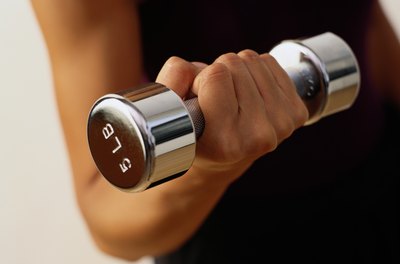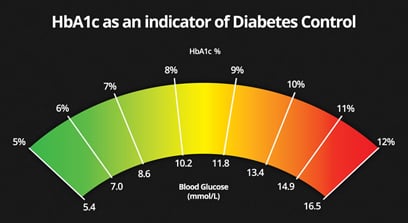Resistance training
 Image taken from https://woman.thenest.com/slimmer-arms-workout-5lb-dumbbells-4481.html
Image taken from https://woman.thenest.com/slimmer-arms-workout-5lb-dumbbells-4481.html
Contents
What is resistance training?
Resistance training, also known as resistance exercise and strength training, is a form of exercise that is performed against external resistance. [1] Resistance is considered to be anything that makes a movement more difficult to perform. [2] Resistance exercise increases the size of muscles, their strength and endurance. [1, 3] There are plenty of different resistance exercise that can be done using bodyweight, dumbbells, kettlebells, machines and resistance bands. [1] Resistance training is becoming more popular as it can be cheap and convenient form of exercise as you can use your own body weight for training and you can do it almost everywhere. [1] Numerous studies have shown that resistance exercise can be beneficial for prevention and control of type 2 Diabetes Mellitus (T2DM) and the risks associated with it. [4]
What are the benefits of resistance training for type 2 Diabetes?
Regular physical activity reduces cardiovascular risk factors and cardiovascular mortality among patients with T2DM, regardless of their age, BMI, blood pressure, total cholesterol and whether they smoke or not. [5,6] It can have a positive effect on metabolic profiles, reduce high blood pressure, increase insulin sensitivity, improve HbA1c, enhance glucose transport and mitochondrial oxidative capacity. [6,7,8,9]
Improving insulin sensitivity
Resistance exercise is known to be effective in improving insulin resistance in both adults and adolescents. [10] There are numerous studies that show this. For instance, a 16 weeks study was done on 22 obese Latino adolescent males showed that 11 individuals who were assigned to twice-per-week resistance training group had an increased insulin sensitivity by 45.1 ± 7.3% (mean±SD) compared to their insulin sensitivity before exercise intervention. 11 adolescents in a non-exercising control group had insulin sensitivity change of -0.9 ± 12.9%, p<0.01 (Figure 1). [10]
Figure 1. Percentage of insulin sensitivity increase for those in resistance training group (n=11) and those in non-exercising control group (n=11). Data shown is mean±SD. [10]
Similarly, a study on 9 obese older men with T2DM also showed how resistance exercise can improve insulin sensitivity. After 16 week, twice-per-week progressive resistance training, participants showed a significant 46.3% increase in insulin sensitivity (from 2.0 ± 1.2 to 2.8 ± 1.6 · 104 · min−1 · μU−1 · ml−1, P < 0.01) and also a significant 7.1% decrease in fasting blood glucose (from 146.6 ± 28.3 to 135.0 ± 29.3 mg/dl, p<0.05). (Figure 2) [11]
Figure 2. Insulin sensitivity index before and after 16-week resistance training (n=9). Data shown is mean ±SD. [11]
Lowering blood glucose concentration
Resistance training can lower venous blood glucose concentrations. This was shown by a clinical trial, which included 11 individuals with T2DM. They completed two trials in random order, one of the trials was a no-exercise trial and the other was a postprandial (45 minutes after meal) resistance exercise trial. One of the observations was that the venous blood glucose concentrations were about 11% lower in the resistance exercise trial (mean=8.0 , SD=0.5 mmol/L) compared to the no-exercise trial (9.0 ± 0.5 mmol/L)(p=0.05), however there was no significant difference in adipose tissue (abdominal area) interstitial glucose concentrations between resistance exercise (10.4 ± 0.7 mmol/L) and no-exercise (10.1 ± 0.7 mmol/L) (Figure 3). These findings could be explained by the increase of blood flow to the skeletal muscle being used during exercise, hence higher uptake of glucose by those muscles and lower concentration of glucose in venous blood, while the blood flow to subcutaneous abdominal adipose tissue was reduced, hence the glucose concentration staying more constant. [12]
Figure 3. Venous and interstitial glucose concentration in resistance exercise and no-exercise trials (n=11). Data shown is mean±SD. [12]
Reducing HbA1c
One of the more important benefits of resistance exercise is that it can reduce HbA1c.[13,14] Glycated haemoglobin HbA1c is used to measure how well blood glucose levels are controlled in patients with diabetes. [14, 15] A study involving 20 patients with T2DM showed that resistance exercise not only reduces HbA1c but that it can be more effective in reducing HbA1c than aerobic training. [13] Participants were assigned to one of two groups, resistance training group or aerobic training group for a 10-week three times per week intervention. The mean baseline HbA1c values for resistance training and aerobic training groups were 8.9 and 8.7%, respectively, both groups being above recommended <7%. While both aerobic and resistance exercise groups showed a significant improvement in HbA1c values of 8% and 18%, respectively, resistance training showed it to a greater extent as 40% of participants reached the recommended HbA1c levels of <7%, while none reached the recommended levels in the aerobic exercise group. [13]
 Image taken from https://www.diabetes.co.uk/newsletter/10-06-2014/
Image taken from https://www.diabetes.co.uk/newsletter/10-06-2014/
Things to consider
It is worth noting that all studies above have a small sample size, so it might not be very representative of the whole population with T2DM. Also, the two studies investigating insulin sensitivity only included males, raising a question if the results can be generalized to women? [10, 11]
The other thing to consider is that resistance exercise is not the best option for everyone. It could be potentially dangerous to people who suffer from cardiovascular diseases or other diseases or disorders. For instance, in a study investigating how resistance training can improve glycaemic control, out of 103 participants, 6 participants experienced adverse events, such as syncopal episodes in participants with known syncope. [16]
Individuals with T2DM should carefully monitor their blood glucose concentration before, during and after resistance exercises, because glucose levels can drop during exercise and they may experience hypoglycaemia. [17]
While resistance training has a positive effect on a lot of people, some people don’t respond to it as well because of the differences in their skeletal muscle transcriptional profile. 18 patients with T2DM participated in 9-month exercise intervention. The aim of this trial was to see if some patients with T2DM would not show exercise induced metabolic improvements. 18 patients were separated to two different groups: Responders and non-responders, based on whether they had or had not improvements in their HbA1c, %fat, BMI and increase in skeletal muscle mtDNA. Using a microarray analysis 186 genes were identified, out of which 70% were up-regulated in Responders and down-regulated in Non-Responders. Some of the genes, involved in metabolic reactions and mitochondrial biogenesis were significantly different between Responders and Non-Responders. This suggests that some individuals have predetermined metabolic response to exercise, based on the expression pattern of their genes and resistance exercise might not be very beneficial to them. [18]
Written by Auste Bakulaite.
References
- Goulding P. What is resistance training? | Nuffield Health [Internet]. Nuffieldhealth.com. 2016 [cited 9 November 2018]. Available from: https://www.nuffieldhealth.com/article/what-is-resistance-training
- Scott J. What Is Resistance Training? Types and Benefits [Internet]. Verywell Fit. 2018 [cited 9 November 2018]. Available from: https://www.verywellfit.com/what-is-resistance-training-3496094
- Weil R. Resistance Training [Internet]. eMedicineHealth. 2017 [cited 9 November 2018]. Available from: https://www.emedicinehealth.com/strength_training/article_em.htm#what_is_resistance_training
- Better Health Channel. Resistance training – health benefits [Internet]. Betterhealth.vic.gov.au. 2018 [cited 9 November 2018]. Available from: https://www.betterhealth.vic.gov.au/health/healthyliving/resistance-training-health-benefits
- Hu G, Jousilahti P, Barengo N, Qiao Q, Lakka T, Tuomilehto J. Physical Activity, Cardiovascular Risk Factors, and Mortality Among Finnish Adults With Diabetes. Diabetes Care [Internet]. 2005 [cited 10 November 2018];28(4):799-805. Available from: https://search.proquest.com/docview/223051072?https://ezproxy.brighton.ac.uk/login?url=accountid=9727&pq-origsite=summon
- Yang P, Swardfager W, Fernandes D, Laredo S, Tomlinson G, Oh P et al. Finding the Optimal volume and intensity of Resistance Training Exercise for Type 2 Diabetes: The FORTE Study, a Randomized Trial. Diabetes Research and Clinical Practice [Internet]. 2017 [cited 10 November 2018];130:98-107. Available from: https://www.researchgate.net/publication/317132993_Finding_the_Optimal_volume_and_intensity_of_Resistance_Training_Exercise_for_Type_2_Diabetes_The_FORTE_Study_a_Randomized_Trial
- Eves N, Plotnikoff R. Resistance Training and Type 2 Diabetes: Considerations for implementation at the population level. Diabetes Care [Internet]. 2006 [cited 11 November 2018];29(8):1933-1941. Available from: http://care.diabetesjournals.org/content/29/8/1933
- Taimela S, Eriksson J, Eriksson K, Parviainen S, Peltonen J, Kujala U. THE EFFECT OF RESISTANCE TRAINING ON LONG-TERM GLYCEMIC CONTROL IN NIDDM SUBJECTS 617. Medicine & Science in Sports & Exercise [Internet]. 1996 [cited 11 November 2018];28(Supplement):104. Available from: https://ovidsp-tx-ovid-com.ezproxy.brighton.ac.uk/sp-3.31.1b/ovidweb.cgi?&S=CNEMFPFDKLDDHBDONCEKEAGCPCDDAA00&Link+Set=S.sh.22%7c6%7csl_10
- Pesta D, Goncalves R, Madiraju A, Strasser B, Sparks L. Resistance training to improve type 2 diabetes: working toward a prescription for the future. Nutrition & Metabolism [Internet]. 2017 [cited 11 November 2018];14(1). Available from: https://nutritionandmetabolism.biomedcentral.com/articles/10.1186/s12986-017-0173-7
- SHAIBI G, CRUZ M, BALL G, WEIGENSBERG M, SALEM G, CRESPO N et al. Effects of Resistance Training on Insulin Sensitivity in Overweight Latino Adolescent Males. Medicine & Science in Sports & Exercise [Internet]. 2006 [cited 11 November 2018];38(7):1208-1215. Available from: https://ovidsp.tx.ovid.com/sp-3.31.1b/ovidweb.cgi?&S=AHILFPCDEODDHBBPNCEKHALBACNIAA00&Link+Set=S.sh.23%7c5%7csl_10
- Ibanez J, Izquierdo M, Arguelles I, Forga L, Larrion J, Garcia-Unciti M et al. Twice-Weekly Progressive Resistance Training Decreases Abdominal Fat and Improves Insulin Sensitivity in Older Men With Type 2 Diabetes. Diabetes Care [Internet]. 2005 [cited 11 November 2018];28(3):662-667. Available from: http://care.diabetesjournals.org/content/28/3/662
- Heden T, Liu Y, Kanaley J. A comparison of adipose tissue interstitial glucose and venous blood glucose during postprandial resistance exercise in patients with type 2 diabetes. Journal of Applied Physiology [Internet]. 2018 [cited 12 November 2018];124(4):1054-1061. Available from: https://www-physiology-org.ezproxy.brighton.ac.uk/doi/full/10.1152/japplphysiol.00475.2017
- Bweir S, Al-Jarrah M, Almalty A, Maayah M, Smirnova I, Novikova L et al. Resistance exercise training lowers HbA1c more than aerobic training in adults with type 2 diabetes. Diabetology & Metabolic Syndrome [Internet]. 2009 [cited 12 November 2018];1(1):27. Available from: https://dmsjournal.biomedcentral.com/articles/10.1186/1758-5996-1-27
- Borkowska A, Szymańska-Garbacz E, Kwiecińska E, Ignaczak A, Czupryniak L. Glucose variability and glycated hemoglobin HbA1c in type 1 and type 2 diabetes. Clinical Diabetology [Internet]. 2017 [cited 12 November 2018];6(2):48-56. Available from: https://journals.viamedica.pl/clinical_diabetology/article/view/51790
- Frayn K. Metabolic Regulation: A Human Perspective. 3rd ed. Oxford: Wiley-Blackwell; 2010.
- Simpson K, Mavros Y, Kay S, Meiklejohn J, de Vos N, Wang Y et al. Graded Resistance Exercise And Type 2 Diabetes in Older adults (The GREAT2DO study): methods and baseline cohort characteristics of a randomized controlled trial. Trials [Internet]. 2015 [cited 12 November 2018];16(1). Available from: https://trialsjournal.biomedcentral.com/articles/10.1186/s13063-015-1037-y
- WebMD. 11 Exercise Tips if You Have Type 2 Diabetes [Internet]. WebMD. 2018 [cited 12 November 2018]. Available from: https://www.webmd.com/diabetes/type-2-diabetes-guide/exercise-guidelines#1
- Stephens N, Xie H, Johannsen N, Church T, Smith S, Sparks L. A transcriptional signature of “exercise resistance” in skeletal muscle of individuals with type 2 diabetes mellitus. Metabolism [Internet]. 2015 [cited 12 November 2018];64(9):999-1004. Available from: https://www.sciencedirect.com/science/article/pii/S0026049515001699?via%3Dihub




